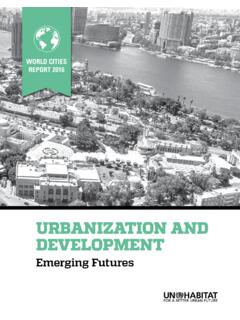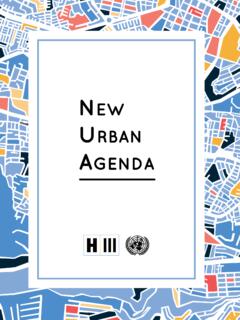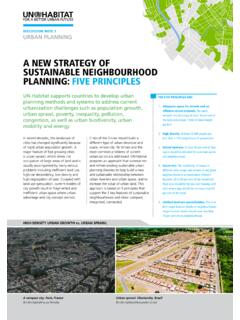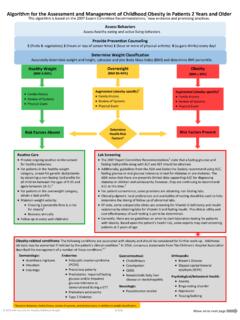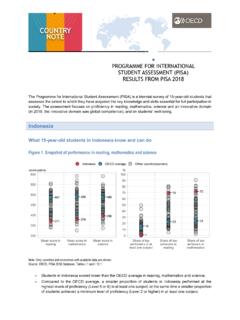Transcription of ADEQUATE HOUSING AND SLUM UPGRADING - UN-Habitat
1 MODULE 1. ADEQUATE HOUSING AND SLUM. UPGRADING . Monitoring and Reporting the SDGs | ADEQUATE HOUSING AND SLUM UPGRADING . ADEQUATE HOUSING AND SLUM. UPGRADING . TARGET : By 2030, ensure access for all to ADEQUATE , safe and affordable HOUSING and basic services and upgrade slums Indicator : Proportion of urban population living in slums , informal settlements or inadequate HOUSING Suggested Citation: UN-Habitat (2018). SDG Indicator Training Module: ADEQUATE HOUSING and Slum UPGRADING . United Nations Human Settlement Programme ( UN-Habitat ), Nairobi. 2 | Indicator Training Module Monitoring and Reporting the SDGs | ADEQUATE HOUSING AND SLUM UPGRADING .
2 SECTION 1: Background INTRODUCTION Sixty per cent of the global population will live in cities by 2030, with 90% of urban growth in coming decades likely to occur in low- and middle-income countries. Current urbanization trends indicate that an additional three billion people will be living in cities by 2050, increasing the urban share of the world's population to two-thirds. In fact, 95% of the growth in urban areas in the next two decades will occur in cities, making them home to more than 4 billion people, and translating to about 80% of future urban population. The steady trend towards urbanization will influence virtually every facet of human endeavor in the coming years, including health, economic, social, and environmental.
3 In many parts of the world, especially in developing countries, high rates of urbanization have unfolded in context of stagnating economies and poor planning and governance, creating a new face of abject poverty concentrated in slums or informal settlements in major cities. Indeed, the unprecedented proliferation of slums and informal settlements in the world especially in developing countries, and a chronic lack of ADEQUATE HOUSING , continue to be among the major challenges of urbanization today. slums , informal settlements and inadequate HOUSING remain the visible manifestations of poverty and inequality in cities.
4 3 | Indicator Training Module Monitoring and Reporting the SDGs | ADEQUATE HOUSING AND SLUM UPGRADING . At present, it is estimated that one in eight people in the world live in slums or experience slum-like conditions around their HOUSING environments'1. Over the next 15 years, it is estimated that more than three billion people will need ADEQUATE HOUSING . The HOUSING and slum challenge therefore remains a critical factor in the persistence of poverty in the world, depriving millions of urban residents their right to an ADEQUATE standard of living and HOUSING ,2 excluding them from the benefits of sustainable urbanization.
5 Mega slums by 2025. Slum Population, Global, 2025. Europe Eastern Asia Western South- Asia Central Asia Forecast of Asian Slum Population as a Percent Northern Africa of Total Slum Population, Latin America Global, 2025. and the Rest Caribbean of the World Southeastern Asia Oceania Asia Sub-Saharan Africa Note: The numbers in the circle are in millions Source: UN-Habitat and Frost & Sullivan analysis. 1 In total, 881,080,000 slum dwellers are estimated to be living in developing countries, only, and this figure has been calculated considering just four out of the five-slum household's deprivations included in the MDG's definition, as security of tenure cannot be accurately calculated yet.
6 In some countries with limited information, only one out of the five components has been measured. Thus, the 881 million can indeed be conside- red a global minimum (United Nations (2015), The Millennium Development Goals Report; UN-Habitat (2016), World Cities Report 2016) . 2 The Universal Declaration of Human Rights (1948), Article 25(1). Committee on Economic, Social and Cultural Rights, General comment No. 4. (1991): The right to ADEQUATE HOUSING (art. 11 (1) of the Covenant). 4 | Indicator Training Module Monitoring and Reporting the SDGs | ADEQUATE HOUSING AND SLUM UPGRADING . In order to design and implement appropriate This is what SDG Indicator does by policies and programs to respond to the HOUSING integrating two aspects of poor HOUSING challenges worldwide, it is important to identify conditions: the aspect of slums and informal and quantify the proportion of the population settlements that UN-Habitat have been that lives in slums within urban areas, those monitoring under the MDGs (Target 7D) mostly living in informal settlements or those who have in developing countries and the new aspect on inadequate HOUSING .
7 Inadequate HOUSING that applies largely to the developed countries. Integrating these two aspects makes the indicator universal as it helps capture HOUSING conditions in both developed and developing countries thus addressing the fundamental principle of leaving no one slums + W S O D T +. Informal Settlements Inadequate HOUSING Figure 2: The different aspects of HOUSING inadequacy-complementarity of three indicators 5 | Indicator Training Module Monitoring and Reporting the SDGs | ADEQUATE HOUSING AND SLUM UPGRADING . Rationale for Monitoring In general, monitoring promotes higher to ADEQUATE , safe and affordable HOUSING and accountability, better performance assessment basic services and upgrade slums .
8 A range and strong coordination between central of interrelated factors usually underlines the governments and the regional and local proliferation of both slums and inadequate governments. It enables cities to collect HOUSING . These may vary from weaknesses accurate, timely, disaggregated data and in HOUSING policies, poor planning and land information, adopting a systemic approach to management, urban migration related to urban the city, with clear policy implications that are densification, disasters, conflicts, long-term based on evidence. This way, countries and poverty as well as the lack of affordable HOUSING .
9 Cities are able to make appropriate decision on All these factors point to the fact that the the best actions to adopt, whilst systematically measurement of all the aspects of the indicator documenting their performance at the outcome will provide a broad field for analysis of the urban and impact levels. related issues towards achieving Agenda 2030. The purpose of monitoring progress against As such, monitoring and reporting on Indicator the SDG 11 Target is to provide necessary is extremely relevant as it integrates the and timely information to decision makers and elements of MDG 7 Target 7D with the SDGs stakeholders in order to make informed decision broader spectrum of HOUSING informality and to accelerate progress towards access for all inadequacy.
10 6 | Indicator Training Module Monitoring and Reporting the SDGs | ADEQUATE HOUSING AND SLUM UPGRADING . Monitoring Process DATA COLLECTION. National Statistical Offices (NSOs) will be responsible for the collection and analysis of data in countries CAPACITY DEVELOPMENT. Final compilation and reporting at the global level will be led and guided by UN-Habitat and selected partners. DATA RELEASE. Regular monitoring and reporting will be done in intervals of 3-5 years based on routine data sources such as censuses and household surveys. 7 | Indicator Training Module Monitoring and Reporting the SDGs | ADEQUATE HOUSING AND SLUM UPGRADING .

